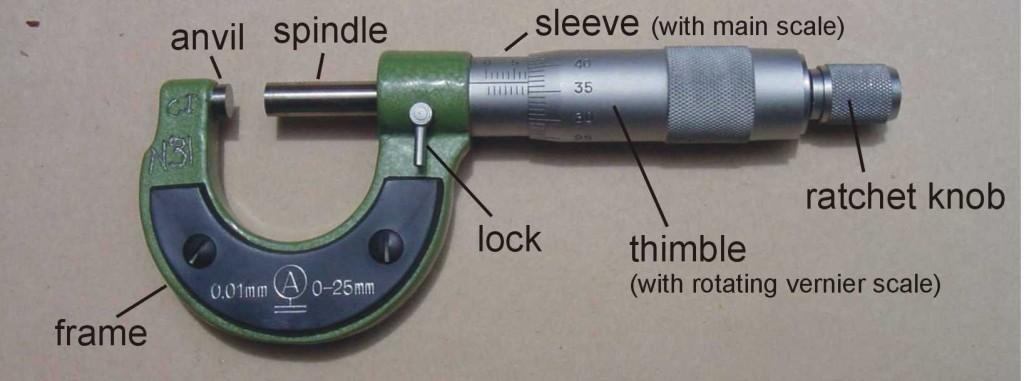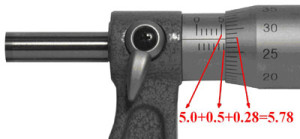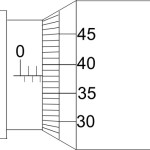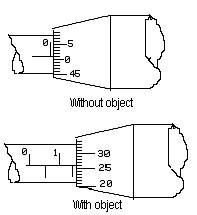Table of Contents
Understanding Micrometer Screw Gauge
Micrometer screw gauges are precision instruments designed for taking small measurements with high accuracy, often used in mechanical engineering, metalworking, and laboratory settings. These tools can measure the dimensions of objects with precision up to the hundredths of a millimeter (0.01 mm) or thousandths of an inch (0.001 inch). This guide will detail the fundamental aspects of reading measurements from a micrometer screw gauge, covering both metric and imperial systems.
Anatomy of a Micrometer Screw Gauge:
- Frame: The C-shaped body that holds and supports the anvil and the barrel.
- Anvil: The fixed measuring surface against which the object to be measured is placed.
- Spindle: The part that moves parallel to the anvil when the thimble is rotated, allowing for the measurement of objects.
- Sleeve (or Barrel): The stationary cylindrical component marked with a scale in millimeters or inches, providing the main unit measurements.
- Thimble: The rotating component that fits over the sleeve, marked with a circular scale that provides further precision to the measurement.
- Ratchet Stop: A mechanism used to apply a consistent measuring force to ensure repeatable and accurate measurements.
- Lock Nut: A feature used to lock the spindle in place once a measurement has been taken, allowing for easy reading without the risk of altering the setting.
Similar to the way a vernier caliper is read, a micrometer reading contains two parts:
- the first part is contributed by the main scale on the sleeve
- the second part is contributed by the rotating vernier scale on the thimble
Measurement Reading Technique For Micrometer
The above image shows a typical micrometer screw gauge and how to read it. Steps:
- To obtain the first part of the measurement: Look at the image above, you will see a number 5 to the immediate left of the thimble. This means 5.0 mm. Notice that there is an extra line below the datum line, this represents an additional 0.5 mm. So the first part of the measurement is $5.0 + 0.5 = 5.5$ mm.
- To obtain the second part of the measurement: Look at the image above, the number 28 on the rotating vernier scale coincides with the datum line on the sleeve. Hence, 0.28 mm is the second part of the measurement.
You just have to add the first part and second part of the measurement to obtain the micrometer reading: $5.5 + 0.28 = 5.78$ mm.
To ensure that you understand the steps above, here’s one more example:
First part of the measurement: 2.5 mm
Second part of the measurement: 0.38 mm
Final measurement: 2.88 mm
Compensating For Zero Error
In A Nutshell
Use the following formula:
$$\text{Correct reading} = \text{Obtained reading} \, – \, \text{Zero error}$$
where $\text{zero error}$ can be either negative (the “0” marking on the thimble is above the datum line) or positive ( the “0” marking on the thimble is below the datum line )
OR
Memorize this:
- Positive Zero Error: If the zero mark on the thimble is below the datum line of the sleeve when fully closed, subtract this value from the total measurement.
- Negative Zero Error: If the zero mark on the thimble is above the datum line when fully closed, add this value to the total measurement.
Explanation For Zero Error Formula
Now, we shall try with zero error. If you are not familiar on how to handle zero error for micrometer screw gauge, I suggest that you read up on Measurement of Length.
The reading on the bottom is the measurement obtained and the reading at the top is the zero error. Find the actual measurement. (Meaning: get rid of the zero error in the measurement or take into account the zero error)
Measurement with zero error: 1.76 mm
Zero error: + 0.01 mm (positive because the zero marking on the thimble is below the datum line)
Measurement without zero error: $1.76 \, – (+ 0.01) = 1.75$ mm
The subtraction logic is similar to the method explained in How to read a vernier caliper. You can take a look and comment below, if you encounter any difficulties.
Tips for Accurate Measurement
- Always clean the object and the micrometer before measuring.
- Use the ratchet stop to apply consistent force when measuring.
- Avoid measuring objects that are too hot or cold, as temperature can affect the dimensions of materials.
- Regularly check and calibrate your micrometer screw gauge to ensure accuracy.
Worked Examples
Example 1
What is the smallest possible reading (in mm) on the thimble scale? What is the biggest possible reading?
Show/Hide Answer
The smallest possible reading on the thimble scale is 0.01 mm, while the biggest possible reading is 0.49 mm.
Example 2
i) In an experiment to measure the diameter of a uniform wire using a micrometer screw gauge, a student fails to notice that with the gauge fully closed, the reading is not zero.
ii) State and explain clearly whether the omission introduces a random error or a systematic error into the readings of the diameter.
Show/Hide Answer
i) The omission introduces a systematic error (zero error). This is because there is a constant error in one direction only, that is, it constantly causes the readings to be either larger or smaller than the true value.
ii) It causes the readings to be precise but not accurate.
Example 3: Basic Measurement
You are measuring the diameter of a small steel rod. The main scale reading is 5 mm, and the thimble scale aligns perfectly at 28 divisions. Calculate the diameter of the steel rod.
Show/Hide Answer
Main Scale Reading = 5 mm
Thimble Scale Reading = 28 divisions × 0.01 mm/division = 0.28 mm
Total Measurement = Main Scale Reading + Thimble Scale Reading = 5 mm + 0.28 mm = 5.28 mm
The diameter of the steel rod is 5.28 mm.
Example 4: Measurement with Zero Error
Before starting your measurement, you notice that when fully closed, the thimble scale’s zero mark is 2 divisions below the sleeve’s baseline, indicating a positive zero error. You measure an object, and the main scale reads 3 mm, with the thimble scale at 15 divisions. What is the object’s corrected measurement?
Show/Hide Answer
Main Scale Reading = 3 mm
Thimble Scale Reading = 15 divisions × 0.01 mm/division = 0.15 mm
Observed Measurement = 3 mm + 0.15 mm = 3.15 mm
Zero Error = 2 divisions × 0.01 mm/division = 0.02 mm (Positive Zero Error)
Corrected Measurement = Observed Measurement – Zero Error = 3.15 mm – 0.02 mm = 3.13 mm
The corrected measurement of the object is 3.13 mm.
Example 5: Negative Zero Error Correction
Upon inspection, the micrometer shows a negative zero error of 5 divisions when fully closed. You measure a metallic sphere, and the sleeve indicates a reading of 4 mm, with the thimble at 22 divisions. Determine the sphere’s accurate diameter.
Show/Hide Answer
Main Scale Reading = 4 mm
Thimble Scale Reading = 22 divisions × 0.01 mm/division = 0.22 mm
Observed Measurement = 4 mm + 0.22 mm = 4.22 mm
Zero Error = 5 divisions × 0.01 mm/division = 0.05 mm (Negative Zero Error)
Corrected Measurement = Observed Measurement + Zero Error = 4.22 mm + 0.05 mm = 4.27 mm
The accurate diameter of the metallic sphere is 4.27 mm.
Example 6: Precision Measurement Challenge
A thin piece of aluminum is measured using a micrometer screw gauge with a known positive zero error of 3 divisions. The main scale reading is exactly 0 mm, and the thimble scale shows 40 divisions. What is the precise thickness of the aluminum piece?
Show/Hide Answer
Main Scale Reading = 0 mm
Thimble Scale Reading = 40 divisions × 0.01 mm/division = 0.40 mm
Observed Measurement = 0 mm + 0.40 mm = 0.40 mm
Zero Error = 3 divisions × 0.01 mm/division = 0.03 mm (Positive Zero Error)
Corrected Measurement = Observed Measurement – Zero Error = 0.40 mm – 0.03 mm = 0.37 mm
The precise thickness of the aluminum piece is 0.37 mm.
Example 7: Advanced Scenario with Larger Zero Error
You’re tasked with measuring the thickness of a glass slide. The micrometer, when fully closed, indicates a negative zero error of 10 divisions. Your measurement reads 2 mm on the main scale and 45 divisions on the thimble scale. Calculate the correct thickness of the glass slide.
Show/Hide Answer
Main Scale Reading = 2 mm
Thimble Scale Reading = 45 divisions × 0.01 mm/division = 0.45 mm
Observed Measurement = 2 mm + 0.45 mm = 2.45 mm
Zero Error = 10 divisions × 0.01 mm/division = 0.10 mm (Negative Zero Error)
Corrected Measurement = Observed Measurement + Zero Error = 2.45 mm + 0.10 mm = 2.55 mm
The correct thickness of the glass slide is 2.55 mm.
If you still do not understand the concept, there is a very useful simulation of the micrometer screw gauge here.




Wow wow it’s good have it’s helpful thanks so much ,